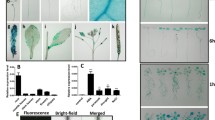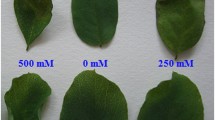Abstract
Leaf chlorosis and bleach in plants under formaldehyde (HCHO) stress has been observed in previous studies. To better understand the mechanism of HCHO inhibition on photosynthesis, effects of HCHO stress on physiological characteristics and gene expression associated with photosynthesis in Arabidopsis thaliana were investigated in this study. The results indicated that HCHO stress reduced total chlorophyll (Chl) and Chl b content but increased Chl a content and a/b ratio in Arabidopsis. Suppression subtractive hybridization analysis identified 22 potential HCHO-repressive genes associated with photosynthesis. Furthermore, RT-PCR data showed that transcriptional levels of Lhcb2.1, Lhcb3, Lhca4, RBCS1A, RCA, Psao, Psbo, and Psbp were reduced to their lowest levels at 4 h after Arabidopsis was treated with 2–4 mM HCHO. The restoration in expression levels of Lhcb3, Lhca4, RBCS1A, and Psbp as well as up-regulation in Lhcb2.1 and RCA transcription was observed from 12 to 24 h after HCHO treatment. 13C-NMR analysis revealed that change patterns of endogenous glucose content were similar to expression patterns of these genes under HCHO stress from 0.5 to 24 h. The glucose content decreased to the lowest level at 4 h, accompanied by a potent inhibition on the capacity of CO2 assimilation caused by exogenous HCHO. From 4 to 24 h of HCHO stress, exogenous HCHO was efficiently metabolized and converted to glucose, which allowed the glucose content to be restored to its original level; thus, repressive effects of HCHO stress on expressions of photosynthesis-related genes were eliminated. These results suggested a correlation between HCHO metabolic level and expression levels of photosynthesis-related genes in vivo during this period. However, a second reduction in expressions of these genes after 36 h might be attributed to other effects triggered by HCHO stress.





Similar content being viewed by others
Abbreviations
- HCHO:
-
Formaldehyde
- C1:
-
One carbon unit
- FALDH:
-
Glutathione-dependent HCHO dehydrogenase
- SSH:
-
Suppression subtractive hybridization
- Chl:
-
Chlorophyll
- Lhca4 :
-
Photosystem I light harvesting complex gene 4
- Lhcb2.1 :
-
Photosystem II light harvesting complex gene 2.1
- Lhcb3 :
-
Photosystem II light harvesting complex gene 3
- Psao :
-
Extrinsic protein of PSI
- Psbo :
-
Extrinsic manganese-stabilizing protein of PSII
- Psbp :
-
Extrinsic protein of PSII
- RBCS1A:
-
Ribulose-1,5-bisphosphate carboxylase oxygenase small subunit 1A
- RCA:
-
Rubisco activase
References
Achkor H, Diaz M, Fernandez MR, Biosca JA, Pares X, Martinez MC (2003) Enhanced formaldehyde detoxification by overexpression of glutathione-dependent formaldehyde dehydrogenase from Arabidopsis. Plant Physiol 132:2248–2255
Blunden G, Carpenter BG, Adrian-Romero M, Yang MH, Tyihak E (1998) Formaldehyde in the plant kingdom. Acta Biol Hung 49:239–246
Chen LM, Yurimoto H, Li KZ, Orita I, Akita M, Kato N, Sakai Y, Izui K (2010) Assimilation of formaldehyde in transgenic plants due to the introduction of the bacterial ribulose monophosphate pathway genes. Biosci Biotechnol Biochem 74:627–635
Flyvholm MA, Andersen P (1993) Identification of formaldehyde releasers and occurrence of formaldehyde and formaldehyde releasers in registered chemical products. Am J Ind Med 24:533–552
Fukusaki E, Ikeda T, Shiraishi T, Nishikawa T, Kobayashi A (2000) Formate dehydrogenase gene of Arabidopsis thaliana is induced by formaldehyde and not by formic acid. J Biosci Bioeng 90:691–693
Giese M, Bauer-Doranth U, Langebartels C, Sandermann H Jr (1994) Detoxification of formaldehyde by the spider plant (Chlorophytum comosum L.) and by soybean (Glycine max L.) cell-suspension cultures. Plant Physiol 104:1301–1309
Heck H, Casanova M (1999) Pharmacodynamics of formaldehyde: applications of a model for the arrest of DNA replication by DNA-protein cross-links. Toxicol Appl Pharmacol 160:86–100
Hester SD, Benavides GB, Yoon L, Morgan KT, Zou F, Barry W, Wolf DC (2003) Formaldehyde-induced gene expression in F344 rat nasal respiratory epithelium. Toxicology 187:13–24
Hickman JW, Witthuhn VC Jr, Dominguez M, Donohue TJ (2004) Positive and negative transcriptional regulators of glutathione-dependent formaldehyde metabolism. J Bacteriol 186:7914–7925
Jin XX, Qin ZW, Wu T, Zhou XY (2011) Identification of ethylene-responsive genes in ethrel-treated shoot apices of cucumber by suppression subtractive hybridization. Plant Mol Biol Rep 29:875–884
Kallen RG, Jencks WP (1966) The mechanism of the condensation of formaldehyde with tetrahydrofolic acid. J Biol Chem 241:5851–5863
Lee MH, Kim YA, Na TY, Kim SH, Shin YK, Lee BH, Shin HS, Lee MO (2008) Identification of formaldehyde-responsive genes by suppression subtractive hybridization. Toxicology 243:224–235
Li Y, Baldauf S, Lim EK, Bowles DJ (2001) Phylogenetic analysis of the UDP-glycosyltransferase multigene family of Arabidopsis thaliana. J Biol Chem 276:4338–4343
Li R, Moore M, Bonham-Smith PC, King J (2002) Overexpression of formate dehydrogenase in Arabidopsis thaliana resulted in plants tolerant to high concentrations of formate. J Plant Physiol 159:1069–1076
Lin K-H, Lin C-H, Chan M-T, Lo H-F (2010) Identification of flooding-response genes in eggplant roots by suppression subtractive hybridization. Plant Mol Biol Rep 28:212–221
Liu Y, Li CM, Lu Z, Ding S, Yang X, Mo J (2006) Studies on formation and repair of formaldehyde-damaged DNA by detection of DNA-protein crosslinks and DNA breaks. Front Biosci 11:991–997
Main DM, Hogan TJ (1983) Health effects of low-level exposure to formaldehyde. J Occup Med 25:896–900
Mason RP, Sanders JKM, Gidley MJ (1986) NMR visualization of free asparagine in potato tissue using adduct formation with [[13]C]formaldehyde. Elsevier, Amsterdam, PAYS-BAS
McNeil SD, Nuccio ML, Rhodes D, Shachar-Hill Y, Hanson AD (2000) Radiotracer and computer modeling evidence that phospho-base methylation is the main route of choline synthesis in tobacco. Plant Physiol 123:371–380
Olson BJ, Skavdahl M, Ramberg H, Osterman JC, Markwell J (2000) Formate dehydrogenase in Arabidopsis thaliana: characterization and possible targeting to the chloroplast. Plant Sci 159:205–212
Sardi E, Tyihak E (1994) Simple determination of formaldehyde in dimedone adduct form in biological samples by high performance liquid chromatography. Biomed Chromatogr 8:313–314
Schmitz H, Hilgers U, Weidner M (2000) Assimilation and metabolism of formaldehyde by leaves appear unlikely to be of value for indoor air purification. New Phytol 147:307–315
Shiraishi T, Fukusaki E, Kobayashi A (2000) Formate dehydrogenase in rice plant: growth stimulation effect of formate in rice plant. J Biosci Bioeng 89:241–246
Song ZB, Orita I, Yin F, Yurimoto H, Kato N, Sakai Y, Izui K, Li KZ, Chen LM (2010) Overexpression of an HPS/PHI fusion enzyme from Mycobacterium gastri in chloroplasts of geranium enhances its ability to assimilate and phytoremediate formaldehyde. Biotechnol Lett 32:1541–1548
Speit G, Schutz P, Hogel J, Schmid O (2007) Characterization of the genotoxic potential of formaldehyde in V79 cells. Mutagenesis 22:387–394
Strain HH, Cope BT, Svec WA (1971) Analytical procedures for the isolation, identification, estimation and investigation of the chlorophylls. Methods Enzymol 23:452–476
Trezl L, Hullan L, Szarvas T, Csiba A, Szende B (1998) Determination of endogenous formaldehyde in plants (fruits) bound to l-arginine and its relation to the folate cycle, photosynthesis and apoptosis. Acta Biol Hung 49:253–263
Trezl L, Hullan L, Jaszay ZM, Szarvas T, Petnehazy I, Szende B, Bocsi J, Takats Z, Vekey K, Toke L (2003) Antagonistic reactions of arginine and lysine against formaldehyde and their relation to cell proliferation, apoptosis, folate cycle and photosynthesis. Mol Cell Biochem 244:167–176
Xu HN, He XZ, Wang K, Chen LM, Li KZ (2011) Identification of early nitrate stress response genes in spinach roots by suppression subtractive hybridization. Plant Mol Biol Rep. doi:10.1007/s11105-011-0376-4
Yang ZJ, Peng ZS, Yang H, Yang J, Wei SH, Cai P (2011) Suppression subtractive hybridization identified differentially expressed genes in pistil mutations in wheat. Plant Mol Biol Rep 29:431–439
Zhang X, Zhen JB, Li ZH, Kang DM, Yang YM, Kong J, Hua JP (2011a) Expression profile of early responsive genes under salt stress in Upland Cotton (Gossypium hirsutum L.). Plant Mol Biol Rep 29:626–637
Zhang XD, Allan AC, Yi Q, Chen LM, Li KZ, Shu Q, Su J (2011b) Differential gene expression analysis of Yunnan Red Pear, Pyrus Pyrifolia, during fruit skin coloration. Plant Mol Biol Rep 29:305–314
Acknowledgments
This work was supported in part by the National Natural Science Foundation of China (grant # 30970263 to L.M.C.) and by the Foundation of Yunnan Province and Kunming University of Science and Technology for Training Adult and Young Leaders of Science and Technology in Yunnan (grant # 2004PY01-5 to L.M.C.).
Author information
Authors and Affiliations
Corresponding author
Electronic supplementary material
Below is the link to the electronic supplementary material.
Online Resource 1
Potential HCHO-repressive genes (except transcripts related photosynthesis and chloroplast structure) identified by SSH analysis (PDF 23 kb)
Online Resource 2
The 13C-NMR spectra of leaf extracts from the plants stressed with 2 mM HCHO for 0.5 (d), 4 (c), 12 (b), and 24 h (a). Complete 13C-NMR spectra (left) and expanded regions of 13C-Gluc signal peaks (right) are shown. The analysis was conducted as described in the “Materials and Methods.” e The sample without treatment. Ref, formamide (166.85 ppm). Arrows indicated the 12 signal peaks of 13C-Gluc (PDF 544 kb)
Online Resource 3
The 13C-NMR spectra of leaf extracts from the control (CK) plants grown on MS agar medium without HCHO stress for 0.5 (d), 4 (c), 12 (b), and 24 h (a). Complete 13C-NMR spectra (left) and expanded regions of the 13C-Gluc signal peaks (right) are shown. e The sample without treatment. Arrows indicated the 12 signal peaks of 13C-Gluc (PDF 557 kb)
Online Resource 4
The 13C-NMR spectra of leaf extracts from the plants labeled with 2 mM H13CHO for 0.5 (d), 4 (c), 12 (b), and 24 h (a). Complete 13C-NMR spectra (left) and expanded regions of the 13C-Gluc signal peaks (right) are shown. The analysis was conducted as described in “Materials and Methods.” e The sample without treatment. Dotted box indicated the 12 signal peaks of 13C-Gluc (PDF 562 kb)
Online Resource 5
Complete 13C-NMR spectra of leaf extracts from the plants treated with 5 mM NaH13CO3 in the presence and absence of 2 mM HCHO stress. The analysis was conducted as described in the “Materials and Methods.” a–e As in Fig. 5 (PDF 510 kb)
Rights and permissions
About this article
Cite this article
Wang, SS., Song, ZB., Sun, Z. et al. Effects of Formaldehyde Stress on Physiological Characteristics and Gene Expression Associated with Photosynthesis in Arabidopsis thaliana . Plant Mol Biol Rep 30, 1291–1302 (2012). https://doi.org/10.1007/s11105-012-0440-8
Published:
Issue Date:
DOI: https://doi.org/10.1007/s11105-012-0440-8




